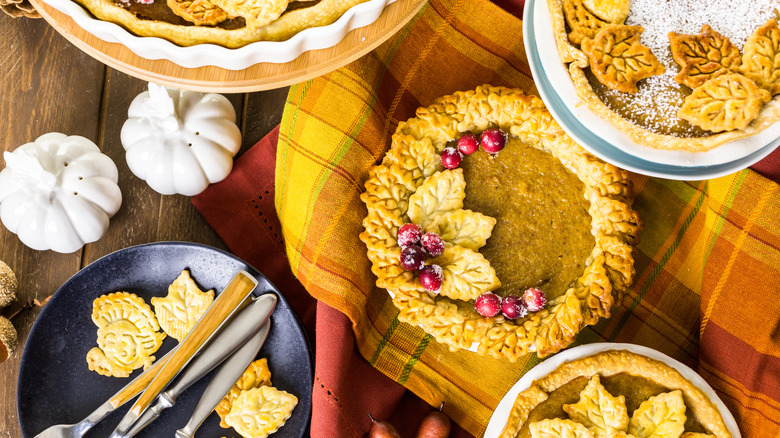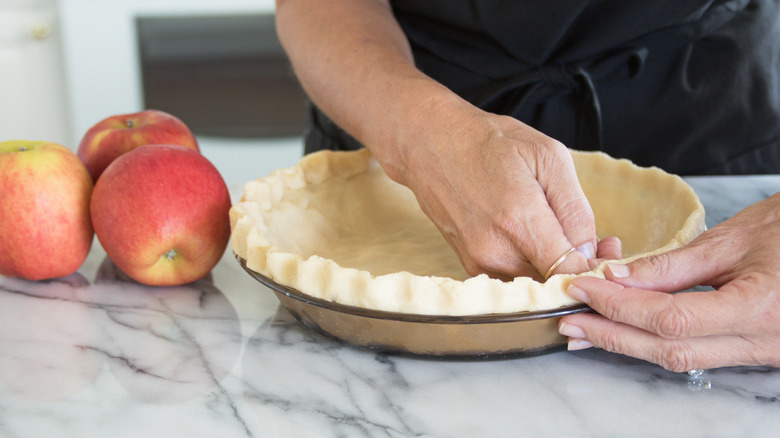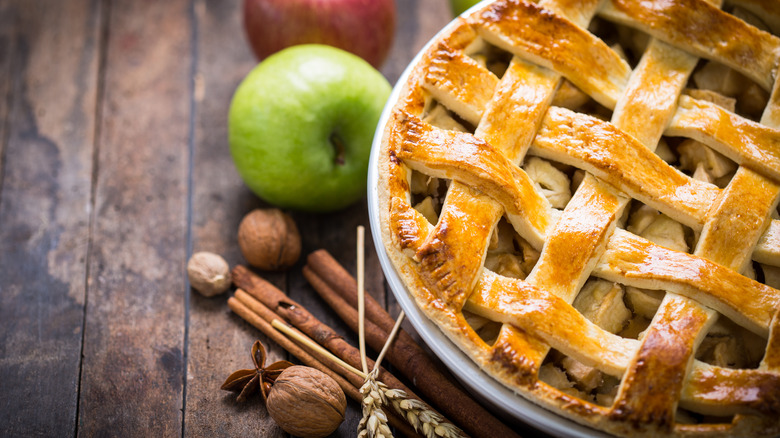Make Store-Bought Pie Crust Look Expensive With A Cookie Cutter Trick
Store-bought pie crusts definitely save you some time and effort, but they can come at the cost of taste, texture, and appearance. Even if you find a brand of crust that tastes great, these products are usually nothing more than flat sheets of pastry, while homemade dough can be woven into intricate patterns. However, store-bought crusts can also be blank canvases for a work of art — all you need are some cookie cutters. The official Allrecipes TikTok account demonstrates this decorating technique, along with a few others.
@allrecipes These designs are EASY AS PIE and can be done very simply on store bought crust. How can it get any better than this? Have you tried any of these quick fixes? 🤔🥧 #pie #piecrust #food
♬ Natural food, cooking and recipes, cooking background music(1324745) – MATSU
Cookie cutters allow you to cut fun shapes out of a sheet of dough and arrange gorgeous designs on top of your pies. Beyond the popular leaves, try flower- or butterfly-shaped cutouts for spring, or holiday-specific symbols like turkeys or Christmas trees. To attach your cutouts to the top of your assembled pie, brush the bottoms of each shape with a bit of water or egg wash, and gently press the pieces down into the top layer of crust or filling.
You can also use cutout shapes to line the perimeter of the pie, as seen in the TikTok. Add another brush of egg wash to the entire crust, and you're ready to bake! Depending on the type of pie you're making, you can also use a fruity substitute for egg wash, like apricot jam, to add a touch of sweetness and a shiny finish.
Other easy ways to decorate with store-bought pie crust
If you don't have decorative cookie cutters on hand, there are other ways to make store-bought pie crust look much prettier. To create a fluted effect around the perimeter of your pie, hold your index finger and thumb about an inch apart along the outside of the crust. Using the index knuckle on your other hand, gently press the crust outward. Repeat around the entire pie for a super-easy scalloped edge.
Alternatively, you can press the crust outward with your index finger and pinch the dough into a point with your other index finger and thumb. Either way, these tricks work particularly well for crimping together the double layers used when baking an apple pie or other traditional double-crusted pie, like peach or cherry. You can also kitchen utensils like a fork or spoon to crimp down the edge of your crust, while adding an appealing visual effect.
To use a fork, drape your top layer of crust over your filling (if using), trim the border, then gently press the fork's tines around the edge of the pie. You can hold the fork perpendicular to the center for a straight crimped pattern, or at an angle for a herringbone effect. If using a spoon, use the rounded tip to carefully create scalloped imprints in the crust, as seen in the Allrecipes video.
More tips for perfecting your pie crust art
Both store-bought and homemade pie crusts need careful handling in order to look their best. Firstly, keep the dough as cold as possible to limit sticking and keep your crust nice and smooth. Chill it thoroughly beforehand, and if it starts to warm up and get sticky, put it back in the fridge for a while. You should also reduce sticking by using flour to dust your fingers, work surface, and any utensils.
Another tip to keep your pie crust looking perfect is to let the dough settle itself into the pie tin, rather than stretching it to fit. You don't want to tear the dough or create an uneven thickness, with some areas stretched too thin and others being thick and doughy. Just drape your sheet of dough over your pan and let it sink in, taking on the shape of the dish. You can then do some trimming and tucking to perfect the fit.
You might also need to blind bake your crust before adding the filling. If you don't own pie weights, choose sugar over rice for a substitute to keep the crust in place. Without weights, the dough will contract and shrink. Last but not least, don't rely solely on a recipe's bake time. For the ultimate golden-brown pie crust, let the pie bake until your senses tell you it's done. This will allow the crust to reach its full, flaky potential.



